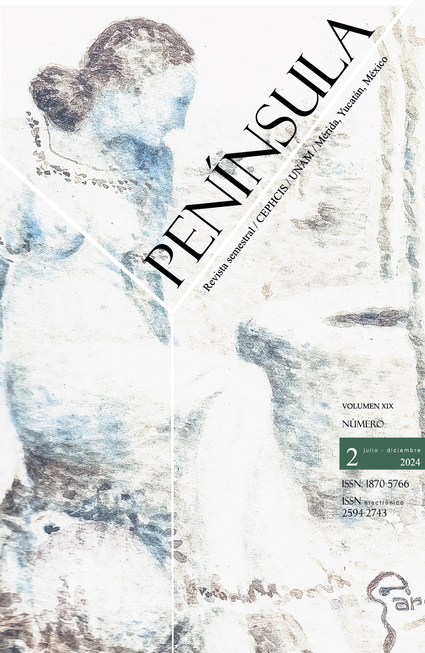Pedagogy, Ekphrasis and Iconotextuality in Two Parallel Passages of the Codex Pérez
Main Article Content
Abstract
In this paper two parallel passages from the Codex Pérez, that constitute an ekphrasis exercise on a table that has not been preserved, are analyzed. A new translation of both fragments is shown, and it is proposed that these kind of tables can be reconstructed through reverse ekphrasis and examined as iconotexts, both in relation to the texts and by themselves.
Downloads
Article Details
Citas en Dimensions Service
References
Artigas Albarelli, Irene. 2013. Galería de palabras: la variedad de la écfrasis. México: Bonilla Artigas- UNAM-Iberoamericana Vervuert.
Barrera Vásquez, Alfredo, dirección. 1980. Diccionario maya Cordemex Maya-español-maya. Mérida: Cordemex.
Berlo, Janet Cahterine. 1983. “Conceptual Categories for the Study of Texts and Images in Mesoamerica”. En Text and Image in Pre-Columbian Art. Essays on the Interrelationship of the Verbal and Visual Arts, edición de Janet Cahterine Berlo, 1-39. Oxford: British Archeological Series.
Bricker, Victoria R. y Helga-Maria Miram. 2002. An Encounter of Two Words. The Book of Chilam Balam of Kaua. Nueva Orleans: Tulane University, Middle American Research Institute.
Códice Pérez. 2024. Consultado el 9 de febrero. http://mediateca.inah.gob.mx/repositorio/islandora/object/codice:1307#page/7/mode/2up.
Chuchiak, John Franklin, IV. 2000. “The Indian Inquisition and the Extirpation of Idolatry: The Process of Punishment in the Provisorato de Indios of the Diocese of Yucatan, 1563-1812”. Tesis de doctorado. Tulane University.
_____. 2004. “The Images Speak: The Survival and Production of Hieroglyphic Codices and Their Use in Post- Conquest Maya Religion 1580-1720). En Continuity and Change. Maya Religious Practices in Temporal Pespective. 5th European Maya Conference. University of Bonn. December 2000, edición de Daniel Graña Bahrens et al., 165-183. Verlag: Anton Saurwein.
_____. 2010. “Writing as a Resistance: Maya Graphic Pluralism and Indigenous Elite Strategies for Survival in Colonial Yucatan, 1550-1750”. Etnohistory 57 (1): 87-116.
Clüver, Claus. 2007. “Intermediality and Interarts Studies”. En Changing Borders. Contemporary Positions in Intermediality, edición de Jans Arvidson et al., 19-37. Lund, Suecia: Intermedia Studies Press. Consultado el 18 de septiembre de 2023. https://lucris.lub.lu.se/ws/portalfiles/portal/7694317/changing_borders_e_bok_.pdf.
Landa, Fray Diego, de. 1938. Relación de las cosas de Yucatán. México: Pedro Robredo.
Craine, Eugene R. y Reginald C. Reindorp. 1979. The Codex Pérez and The Book of Chilam Balam of Maní. Norman: University of Oklahoma Press.
George-Hirons, Amy. 2015. “Yokol cab: Mayan Translation of European Astrological Texts and images in the Book of Chilam Balam of Kaua”. Etnohistory 62 (3): 525-552.
Giovine Yáñez, María Andrea. 2020. “Toda obra de artes visuales es iconotextual: una invitación a pensar la historia de las artes visuales desde la relación entre las obras y sus títulos”. Hiperborea. Revista de ensayo y creación, 3: 71-95.
Heffernan, James A. W. 1993. Museum of Words. The Poetics of Ekphrasis from Homer to Ashbery. Chicago y Londres: The University of Chicago Press.
Houston, Stephen y Andréas Stauder. 2020. “What is a Hieroglyph?” L’Home. Revue Française d’ Antropologie, 233: 4-44.
Kent Trejo, Didanwy Davina. 2016. “ ‘Resonancias’ de la promesa: ‘ecos’ y ‘reverberaciones’ del Don Giovanni. Un estudio de los desplazamientos de la imagen intermedial”. Tesis de doctorado en Historia del Arte. UNAM.
Quezada, Sergio y Tsubasa Okoshi Harada. 2001. Papeles de los Xiu de Yaxhá, Yucatán, vol. 15 Fuentes para el Estudio de la Cultura Maya. México: UNAM.
Real Academia Española. Diccionario de la lengua española. Actualización 2021. https://www.rae.es/.
Salazar Lama, Daniel y Rogelio Valencia Rivera. 2017. “The Written Adornment: The Many Relations of Text and Image in Classic Maya Visual Culture”. Visible Language 51 (2): 80-103.
Scandar, Florencia. 2017. “Juan Pío Pérez Bermón: vida y obra de un ilustrado yucateco del siglo xix”. Tesis de doctorado. Universidad Complutense de Madrid.
Scandar, Florencia. 2021. “Uchibil kin, uchibil u. Los eclipses en los libros de Chilam Balam: reelaboración y remediación”. Revista Española de Antropología Americana, 51: 83-105.
Solís Alcalá, Ermilo. 1949. Códice Pérez. Mérida: Ediciones de la Liga de Acción Social-Imprenta de Oriente.
Stone, Andrea y Marc Zender. 2011. Reading Maya Art. A Hieroglyphic Guide to Ancient Maya Painting and Sculpture. Londres: Thames & Hudson.
Suárez Castro, María Guadalupe. 2017. “Los privilegios y honras nobiliarias de Don Juan Xiu Cimé, chilan de Oxkutzcab”. Oficio. Revista de Historia e Interdisciplina 5 (julio-diciembre): 47-60.
Villanueva, Darío. 2015. Imágenes de la ciudad. Poesía y cine, de Whitman a Lorca. Madrid: Ediciones Cátedra.
Webb, Ruth. 1999. “Ekphrasis Ancient and Modern: The Invention of a Genre”. Word & Image 15 (1): 7-18.
Wiesing, Lambert. 2014. “What are Media?”. En Techne/ Technology, edición de Annie van den Oever, 93-102. Ámsterdam: Amsterdam University Press.
